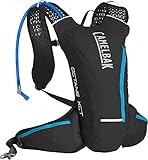Last Updated on October 28, 2021
Hydration packs are becoming increasingly popular these days because most mountain bikers find them more convenient than carrying with them a water bottle.
Not only do these provide the rider easy access for hydration, but they also ensure that they keep their balance and control intact.
They don’t need to remove their hand from the handlebar for a long time just to reach out to the bottle. Instead, you just need to flick your hand for a millisecond to bring the hydration valve to your mouth. You can then continue pedaling while sipping water from the hydration pack.
But a common question many mountain bikers ask is if you can put your hydration pack in any bag.
That is what this article will answer. We will show you the factors that determine if you can fit a hydration bladder on a bag. We’ll also provide detailed information on the different types of backpacks so you can get the right one for you.
Can you fit a hydration bladder in any backpack?
Yes, but not all the time. Take note, though, that you can put a water bladder in any backpack. There’s just no assurance that it can fit perfectly.
You have to consider many different factors that affect its fits, such as reservoir capacity, the type of bag, and the many factors present in hydration packs.
Many premium cycling hydration backpacks have a built-in hydration reservoir. But you don’t have to worry if your bag doesn’t come with one because you can add a hydration bladder easily.
What are the different types of hydration packs?
Cycling backpacks
Cycling backpacks are the most common hydration bag out there. They are specifically designed for cycling, whether it be cross-country, trail, or downhill.
These are usually strapped to your chest with their main platform on your back. They are lightweight, stable, and comfortable to bring even on long rides and uphill descent.
Waist packs
Waist packs are similar to the design of the backpacks. But instead of hanging from your back, they are strapped to your waist. They are ideal if you don’t want to compromise ventilation and breathability.
They are also lightweight and are made of special fabrics that wick out sweat. If you want to maximize airflow, specifically on your back, then this one’s what you need. Just remember that you can’t bring a lot of water with you.
What are the things to consider when buying a hydration pack?
Capacity
The first thing to consider is the capacity of the water bladder. Carrying water is not easy because it puts weight on your back, which becomes a huge hassle if you’re in for long epic rides.
Also, the most important thing you should remember is to estimate the duration of your ride in relation to the water you put in the water bladder so you don’t end up lugging a heavy bag on your back.
Material
Consider the material your hydration pack is made of. A good hydration bladder isn’t just made of plastic. Instead, they’re a combination of premium plastic and rubber.
These should also not affect the quality of the water you put into it when it is directly exposed to sunlight. Choose hydration bladders made from a high-quality plastic material that is partially rubberized as these are the most durable. They also don’t give off that much weird taste.
Size
Choose the right water bladder size that complements your riding style. If you’re into cross-country mountain biking, then it makes sense to get a larger hydration pack because you need to be hydrated regularly for long epic rides.
Meanwhile, you can opt for a smaller water bladder if you’re into downhill because you won’t need to risk reaching out to your hydration tube while you’re running at 60 to 80 miles per hour on a steep downhill trail.
Comfort and functionality
Always consider comfort and functionality because this is what makes your hydration bladder a bang for the buck. You shouldn’t have a hard time carrying it with you on your back and shoulders or sipping water from the bite valve because this will affect your riding experience.
It should also be functional in the sense that it has many features such as tool pockets, velcro straps, and many more. It’s all about improving your riding experience, which is why you need to ensure the hydration system is made with these in mind.
Brand
The brand is another important factor to consider. Although many people will say that this is just being too much of an elitist, it doesn’t work that way in mountain biking. You see, the top brands all equate to top-tier quality.
This means that it makes perfect sense for you to choose the best and most known hydration bladder brands out there just like Camelbak, Osprey, and Fox Racing. You can also check reviews of users online to see if your chosen water bladders are a good choice.
Price
Then comes the price. We recommend you go for the expensive ones because they are of high quality. As mentioned earlier, Camelbak, Osprey, and Fox Racing are the top brands out there, but they also come at a steep price.
| Image | Title | Price | Prime | Buy |
|---|---|---|---|---|
 | CamelBak Octane XCT 70 Crux Reservoir Hydration Pack, Black/Atomic Blue, 2 L/70 oz | PrimeEligible | No Results | |
 | Osprey Seral 7 Lumbar Bike Hydration Pack, Black, One Size | PrimeEligible | No Results | |
 | Fox Racing Utility Hydration Pack- Small, Black, One Size | PrimeEligible | No Results |
Don’t worry, though, if you think that’s too much for a hydration bladder because you’ll get what your money is worth. Although they can cost anywhere from $80 to $150 or even more, you can expect to use them for years. They don’t easily get torn or get damaged.
Related: How Do I Choose a Hydration Backpack
Conclusion
Hydration packs are a must-have if you are into long rides. We don’t recommend these if you are racing, though, because these can slow you down.
And, though, they might compromise a bit of breathability and airflow compared to a water bottle, they can still surely carry a lot of water compared to water bottles to keep you hydrated and more convenient with the help of its bite valve, shoulder straps, hydration pocket, and chest harness, with all these being present in their hydration system.
And don’t worry if your hydration pack doesn’t come with a backpack. You can get another backpack, but just make sure that it’s specifically made for cycling hydration bladders.
You can’t just fit a hydration bladder on any backpack. It needs a compatible bag that complements its size, shape, and design.
Related: How Long Do Hydration Bladders Last?
